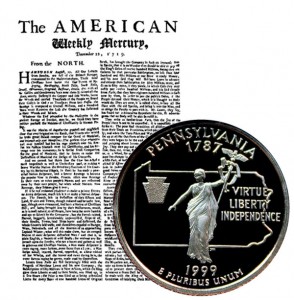Today, the Pennsylvania State Quarter Coin remembers the publication of the first middle colonies’ newspaper 296 years ago.
Published in 1898, the Preface to the republication of The American Weekly Mercury: December 22, 1719 – December 20, 1720, Volume 1, Issues 1-52 describes how the early Colonial newspapers provided information to their subscribers.
=====
THE AMERICAN WEEKLY MERCURY, the republication of which has been undertaken by The Colonial Society of Pennsylvania, was the first newspaper published in the Middle Colonies and the fourth in order of time published in America.
Three other weeklies had previously been begun in New England. The first of these, Public Occurrences, printed at Boston, September 25th, 1690, was an abortive attempt which ended with the first number; the second, The Boston News-Letter, begun in 1704, had a long career; and the third, The Boston Gazette, which appeared just one day earlier than The Mercury.
The first number of The American Weekly Mercury was issued at Philadelphia on December 22d, 1719, by Andrew Bradford, the founder of the “newspaper” in the Middle Colonies.
It was a “potfolio ” of two pages at first, which later regularly became four for the weekly issue, except on rare occasions, when it was expanded to six and even eight pages.
In its “make-up” Bradford simply followed its predecessors in New and Old England.
The first page was given up to European news, scissored out of other papers, and then came items from Boston and the eastward, thence southwardly to New York, under which heading a paragraph was rarely wanting, then New Jersey’s items, which were followed by news from the Southern Colonies and the West Indies.
These paragraphs were followed by a heading, “Philadelphia,” in which was included the local news, not only of this city, but of the whole Province of Pennsylvania.
After this came the shipping news, prices current and the advertisements.
At the bottom of the last page appeared the printer’s address, coupled with the announcement that at the latter “advertisements were taken in,” ” linen rags bought,” and “very good lampblack sold.”
It was at best, as Franklin says, “a paltry thing,” but then it must be added that his own paper, The Pennsylvania Gazette, was frequently no better.
The Mercury was at first wholly made up of extracts from the London journals, the shipping news and a few advertisements.
As years rolled on local politics led to the occasional insertion of an article or two on the ” burning questions of the day,” generally in the form of a letter to Mr. Bradford, but sometimes in the shape of a “leader” of a modern newspaper.
As local politics waxed hot or waned these articles occupied a space proportionate to the occasion.
News from the neighborhood in time found a place, and occasionally a local fire, robbery, or murder was chronicled.
The arrival of a new Governor, with the consequent addresses from the Provincial Assembly, the corporation of Philadelphia, and minor local bodies, were generally given a prominent place, and later on an obituary of some person of note found a place.
The arrival from time to time of the “palatines,” the progenitors of a most important factor in the population, progress, and history of Pennsylvania, is duly chronicled.
One very interesting paragraph appears on page 94, and records the arrival of ” the ship ‘Laurel,’ John Coppel, from Liverpoole and Cork, with two hundred and forty palatine passengers come here to settle,” a fact which was hitherto unknown.
It was a peculiarity of the early newspapers that, while they devoted but scant space to local items, which were the common talk, they contained news of neighboring towns and provinces not to be found for the same reason in the special publications of those localities, and The Weekly Mercury, like its contemporaries, had a wide interest outside of Philadelphia.
Under the headings of New York, Boston, Charleston and other places are found many interesting and important pieces preserved nowhere else.
In the nineteenth and twentieth volumes of the New Jersey Archives may be seen the kind of material The American Weekly Mercury contains, so far as it relates to New Jersey and her citizens, and from these may be judged how great a mass of interesting matter, not only local but continental, lies buried in these old newspapers.
The genealogist will find in the scraps of news, the occasional obituaries and in the advertisements facts of interest and value not otherwise obtainable.
The political economist will discover much instructive information, and the local historian will have at his command, for the first time, a new mass of material with which to color his narrative.
The advertisements are sources of information of every kind and are invaluable to the searcher after historical facts.
The Committee cannot omit mention of Mr. Julius F. Sachse, to whose skill and care is due the perfection of the reproduction.
THE COMMITTEE ON PUBLICATION.
=====
The Pennsylvania State Quarter Coin shows beside an image of a portion of the first American Weekly Mercury newspaper.
